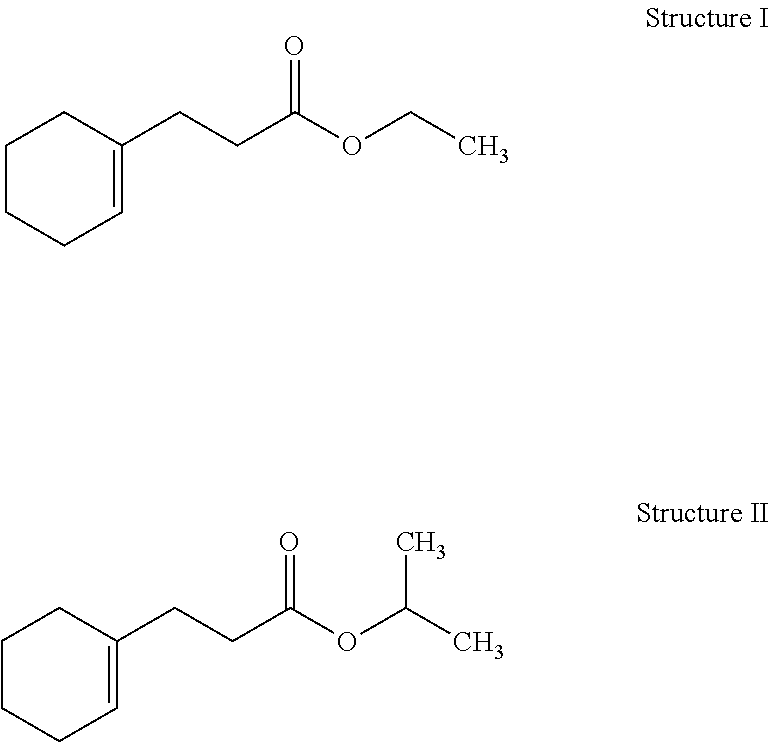3-(cyclohex-1-en-1-yl)propionates and their use in perfume compositions
a technology of propionate and cyclohexaenone, which is applied in the preparation of detergent mixture compositions, detergent compounding agents, disinfection, etc., can solve the problems of difficult to identify desirable fragrance chemicals, difficult to predict the effectiveness of a given structure, and often undesirable, etc., to achieve the effect of enhancing, improving or modifying the fragrance of perfumes, colognes, and toilet water
- Summary
- Abstract
- Description
- Claims
- Application Information
AI Technical Summary
Benefits of technology
Problems solved by technology
Method used
Image
Examples
example i
[0036]
[0037]Preparation of Ethyl 3-(Cyclohex-1-en-1-yl)propionate (Structure I): A 2-L reaction flask equipped a reflux condenser and a Dean Stark trap was charged with bicyclononalactone (commercially available from IFF) (600 g, 3.89 mol), butanol (432 g, 5.8 mol) and methanesulfonic acid (MSA) (18.7 g, 0.19 mol). The reaction mixture was heated to reflux at 110-120° C. for 4-6 hours. Water (˜50 mL) was collected in the Dean Stark trap. The reaction mixture was then cooled to an ambient temperature, neutralized with aqueous sodium carbonate (Na2CO3) (10%, 100 mL) and washed with brine (1 L). Flash vacuum distillation at a boiling point of 160-175° C. and a pressure of 3 mmHg afforded crude butyl 3-(cyclohex-1-en-1-yl)propionate. Subsequently, a 3-L reaction flask equipped a reflux condenser was charged with the crude butyl 3-(cyclohex-1-en-1-yl)propionate (700 g) from the previous step, ethanol (1 L) and MSA (10 g, 0.1 mol). The reaction mixture was heated to reflux at 80-100° C. f...
example ii
[0039]
[0040]Preparation of 2-Propyl 3-(Cyclohex-1-en-1-yl)propionate (Structure II): A 3-L reaction flask equipped a reflux condenser was charged with crude butyl 3-(cyclohex-1-en-1-yl)propionate (421 g, 2 mol) (prepared as above in EXAMPLE I), 2-propanol (IPA) (2 L) and aqueous sodium hydroxide solution (NaOH) (50% by weight) (240 g, 3 mol). The reaction mixture was heated to reflux at 80-85° C. for 8 hours. The reaction mixture was then cooled to an ambient temperature and acidified with hydrochloric acid (HCl) (37%, 400 mL). Toluene (500 mL) was added and the reaction mixture was washed with brine (2 L). The organic layer was removed via a separatory funnel. Toluene was recovered using a Buchi Rotary Evaporator to afford solvent-free crude 3-(cyclohex-1-en-1-yl)propionic acid. Subsequently, a 2-L reaction flask equipped a reflux condenser was charged with the crude 3-(cyclohex-1-en-1-yl)propionic acid from the previous step, IPA (1.5 L) and sulfuric acid (H2SO4) (98%, 10 g). The ...
example iii
[0042]
[0043]Preparation of Allyl 3-(cyclohex-1-en-1-yl)propionate (Structure III): A 3-L reaction flask equipped a reflux condenser was charged with crude 3-(cyclohex-1-en-1-yl)propionic acid (400 g, 2.5 mol) (prepared as above in EXAMPLE II), methanol (MeOH) (2 L) and H2SO4 (98%, 18 g). The reaction mixture was heated to reflux at 65-75° C. for 8 hours. The reaction mixture was then cooled to an ambient temperature and diluted with toluene (500 mL). The reaction mixture was neutralized with aqueous Na2CO3 (10%, 2 L) and washed with brine (1 L) to obtain crude methyl 3-(cyclohex-1-en-1-yl)propionate. Subsequently, a 2-L reaction flask equipped a reflux condenser and a Dean Stark trap was charged with the crude methyl 3-(cyclohex-1-en-1-yl)propionate from the previous step, allyl alcohol (CH2═CHCH2OH) (282 g, 4.8 mol) and sodium methoxide (NaOMe) (11 g, 0.2 mol). The reaction mixture was heated to reflux at 65-85° C. for 8 hours. Methanol was removed. The reaction was then cooled to ...
PUM
| Property | Measurement | Unit |
|---|---|---|
| weight percent | aaaaa | aaaaa |
| weight percent | aaaaa | aaaaa |
| weight percent | aaaaa | aaaaa |
Abstract
Description
Claims
Application Information
 Login to View More
Login to View More - R&D Engineer
- R&D Manager
- IP Professional
- Industry Leading Data Capabilities
- Powerful AI technology
- Patent DNA Extraction
Browse by: Latest US Patents, China's latest patents, Technical Efficacy Thesaurus, Application Domain, Technology Topic, Popular Technical Reports.
© 2024 PatSnap. All rights reserved.Legal|Privacy policy|Modern Slavery Act Transparency Statement|Sitemap|About US| Contact US: help@patsnap.com










